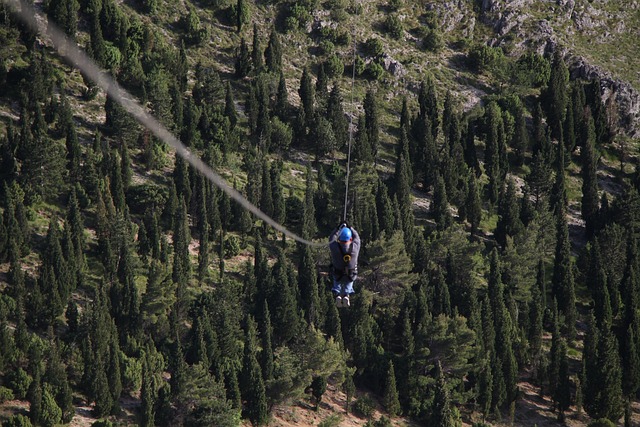Ziplining has become a popular outdoor activity that allows individuals to soar through the air while experiencing stunning views. However, many people wonder if ziplining can cause motion sickness.
Motion sickness is a condition that can make individuals feel dizzy, nauseous, and lightheaded. While individual experiences may vary, studies have shown that ziplining does not significantly increase the risk of motion sickness in healthy adults.
However, some individuals may experience motion sickness while ziplining due to rapid movement and changes in altitude.
In this post, I will explore the relationship between ziplining and motion sickness. I will discuss what causes motion sickness, examine whether ziplining can trigger it, and provide tips on how to prevent it while enjoying this thrilling activity. By the end of this post, you will have a better understanding of how to stay safe and comfortable during your next zipline adventure. Let’s get to it!
What causes motion sickness?
Motion sickness is caused by a conflict between the visual and vestibular (inner ear) systems, which are responsible for maintaining balance and orientation in the body. When these two systems receive conflicting information, such as when you are sitting in a stationary car but your eyes perceive motion outside, it can cause the brain to become confused and result in symptoms of motion sickness.
Other factors that can contribute to motion sickness include anxiety, dehydration, fatigue, and the type of motion being experienced (e.g., swaying, spinning, or tilting). Common symptoms of motion sickness include dizziness, nausea, vomiting, sweating, and headaches.
Does ziplining cause motion sickness?
There is no straightforward answer to whether ziplining causes motion sickness because it can vary depending on the individual. Some people may experience motion sickness while ziplining due to rapid movement and changes in altitude, while others may not feel any symptoms. Studies have shown that motion sickness is more likely to occur when the vestibular and visual systems receive conflicting information while in motion.
However, ziplining is generally a smooth and steady activity that does not involve sudden or erratic movements. Therefore, the risk of motion sickness while ziplining is relatively low compared to other activities that involve more jarring or unpredictable movements, such as roller coasters or boats. If you are concerned about experiencing motion sickness while ziplining, it is best to consult with your doctor and follow the tips for preventing motion sickness.
Studies and research
There have been a limited number of studies on the relationship between ziplining and motion sickness. However, a study published in the Journal of Vestibular Research found that ziplining does not significantly increase the risk of motion sickness in healthy adults. The study involved 26 participants who completed a zipline course and were monitored for symptoms of motion sickness. The researchers found that only two participants reported mild symptoms of motion sickness, while the rest did not experience any symptoms.
Another study published in the Journal of Travel Medicine examined the prevalence of motion sickness among adventure tourists, including those who participated in ziplining. The study found that motion sickness was more common in adventure tourists than in the general population, but that the severity of motion sickness was relatively mild. The researchers also found that ziplining was not a significant predictor of motion sickness and that other factors such as age, gender, and previous history of motion sickness played a greater role in determining susceptibility.
While there is limited research on the topic, the available evidence suggests that ziplining is generally a safe activity that is unlikely to cause motion sickness in most people. However, individual experiences may vary, and it is always best to consult with your doctor if you have concerns about your health or ability to participate in physical activities.
Experiences of individuals who have been on a zipline
Individual experiences of motion sickness while ziplining can vary depending on a variety of factors such as age, previous history of motion sickness, and the intensity of the zipline experience. Some individuals may report feeling slight dizziness or nausea during or after a zipline ride, while others may not experience any symptoms at all.
Several online forums and reviews show that some individuals do experience motion sickness while ziplining, while others do not. For example, some people have reported feeling dizzy or nauseous during a zipline ride due to the high speeds and changes in altitude, while others have reported feeling no discomfort at all. However, the majority of reviews suggest that motion sickness is not a common occurrence during ziplining and that most people can participate in this activity without any issues.
It is important to note that individual experiences of motion sickness can be subjective and may depend on various factors such as the type of zipline, the individual’s health status, and other external factors. If you are concerned about experiencing motion sickness during a zipline ride, it is recommended to consult with your doctor and follow the tips for preventing motion sickness.
Comparison of ziplining to other activities that cause motion sickness
Ziplining is generally considered a low-risk activity for motion sickness when compared to other activities that involve more intense or unpredictable movements. Here are some examples of activities that may be more likely to cause motion sickness than ziplining:
- Roller coasters: Roller coasters involve rapid changes in speed, altitude, and direction, which can cause a lot of movement and confusion for the vestibular and visual systems. These factors can contribute to symptoms of motion sickness such as dizziness and nausea.
- Boating: Being on a boat can cause motion sickness due to the constant movement and rocking of the waves. This motion can also create a conflict between the visual and vestibular systems, leading to symptoms of motion sickness.
- Virtual reality experiences: Virtual reality experiences involve simulating movements and sensations that can be disorienting for the brain. The disconnect between virtual reality and real-world movement can lead to motion sickness in some individuals.
Overall, ziplining is considered a relatively low-risk activity for motion sickness compared to other activities that involve more intense or unpredictable movements. However, it is important to remember that individual experiences can vary, and some people may still experience motion sickness while ziplining.
How to prevent motion sickness while ziplining
If you are prone to motion sickness or are concerned about experiencing it while ziplining, there are several steps you can take to prevent or minimize symptoms. Here are some tips to help you prevent motion sickness while ziplining:
- Choose a slow and steady zipline: Choose a zipline that is slow and steady, rather than one that involves rapid changes in speed or direction. This will help reduce the likelihood of motion sickness.
- Stay hydrated: Dehydration can worsen symptoms of motion sickness, so make sure to drink plenty of fluids before and during your zipline experience.
- Eat light and avoid greasy or spicy foods: Eating a light meal before ziplining can help reduce the risk of motion sickness. Avoid greasy or spicy foods, which can exacerbate symptoms.
- Focus on a fixed point: Fix your gaze on a fixed point in the distance, such as a tree or a landmark, rather than looking down or around. This can help reduce the visual confusion that can lead to motion sickness.
- Take breaks: If you start to feel motion sickness coming on, take a break and step off the zipline platform for a few minutes to rest and recover.
- Consider medication: Over-the-counter motion sicknesses medications, such as dimenhydrinate or meclizine, can help alleviate symptoms. Talk to your doctor before taking any medication to make sure it is safe for you to use.
By following these tips, you can help reduce the risk of motion sickness and enjoy a fun and comfortable zipline experience.
Suggestions for preparing for a zipline experience
If you are planning to go ziplining, there are a few things you can do to prepare for your experience and make sure it is enjoyable and safe. Here are some suggestions for preparing for a zipline experience:
- Check the weather: Ziplining is a weather-dependent activity, so make sure to check the weather forecast before you go. If there is a chance of rain or thunderstorms, consider rescheduling your zipline experience for a different day.
- Wear appropriate clothing: Wear comfortable, loose-fitting clothing that allows for a full range of motion. Avoid wearing clothing with strings or loose items that could get caught in the zipline or trolley.
- Wear closed-toe shoes: Closed-toe shoes with good grip are essential for ziplining. Avoid sandals, flip-flops, or shoes with heels.
- Follow safety guidelines: Listen carefully to the safety guidelines provided by your zipline operator and follow all instructions carefully. Make sure your harness and zipline equipment is properly fitted and secured before starting your zipline ride.
- Practice on smaller ziplines: If you are new to ziplining or have not done it before, consider starting with smaller ziplines to get a feel for the experience before moving on to longer or higher ziplines.
- Be mindful of your health: If you have any health conditions or concerns, such as back pain or neck problems, motion sickness, or pregnancy, talk to your doctor before going ziplining to make sure it is safe for you to participate.
By following these suggestions and taking the necessary precautions, you can ensure that your zipline experience is safe, comfortable, and enjoyable.
Medications that can help with motion sickness
Several over-the-counter medications can help alleviate symptoms of motion sickness, including:
- Dimenhydrinate: This medication, sold under the brand name Dramamine, is an antihistamine that can help reduce dizziness, nausea, and vomiting associated with motion sickness. It is available in both pill and chewable tablet form.
- Meclizine: This medication, sold under the brand name Bonine, is another antihistamine that can help alleviate symptoms of motion sickness. It is available in both pill and chewable tablet form.
- Scopolamine: This medication is available as a prescription patch that is placed behind the ear. It works by blocking the signals that cause nausea and vomiting. It is typically used for longer journeys, such as cruises or transatlantic flights.
- Ginger: While not technically a medication, ginger has been shown to have anti-nausea properties and can help alleviate symptoms of motion sickness. It is available in a variety of forms, including ginger chews, ginger tea, and ginger supplements.
It is important to talk to your doctor before taking any medication for motion sickness, especially if you have any underlying health conditions or are taking other medications. Your doctor can help you determine the best medication and dosage for your individual needs.
Conclusion
Ziplining can be an exciting and memorable experience for those who enjoy outdoor activities. While motion sickness is a possibility, it is important to remember that ziplining is generally a safe and low-risk activity for motion sickness when compared to other activities that involve more intense or unpredictable movements.
By taking the necessary precautions, such as staying hydrated, eating light, and focusing on a fixed point, individuals can reduce the risk of motion sickness and enjoy a comfortable zipline experience. Additionally, it is important to prepare for a zipline experience by checking the weather, wearing appropriate clothing and closed-toe shoes, and following safety guidelines.
Overall, ziplining can be a fun and exhilarating way to explore nature and experience breathtaking views, and with proper preparation and precautions, it can be enjoyed by individuals of all ages and health conditions.










